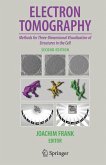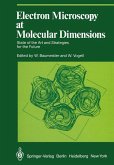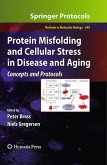- Broschiertes Buch
- Merkliste
- Auf die Merkliste
- Bewerten Bewerten
- Teilen
- Produkt teilen
- Produkterinnerung
- Produkterinnerung
Electron microscopy in the biological sciences can be divided into two disciplines. The first, concerned with high resolution detail of particles or periodic structures, is mostly based on sound theoretical principles of physics. The second, by far the larger discipline, is interested in the information obtainable from thin sections. The theoretical back ground to those groups of techniques for preparing and looking at thin sections is often inexact and "loose", for want of a better word. What should be chemistry is often closer to alchemy. This kind of electron microscopy is often enshrined…mehr
Andere Kunden interessierten sich auch für
![Crystalline Bacterial Cell Surface Layers Crystalline Bacterial Cell Surface Layers]() Crystalline Bacterial Cell Surface Layers77,99 €
Crystalline Bacterial Cell Surface Layers77,99 €![Methods of Preparation for Electron Microscopy Methods of Preparation for Electron Microscopy]() David G. RobinsonMethods of Preparation for Electron Microscopy77,99 €
David G. RobinsonMethods of Preparation for Electron Microscopy77,99 €![Electron Tomography Electron Tomography]() FrankElectron Tomography177,99 €
FrankElectron Tomography177,99 €![Electron Microscopy at Molecular Dimensions Electron Microscopy at Molecular Dimensions]() Electron Microscopy at Molecular Dimensions77,99 €
Electron Microscopy at Molecular Dimensions77,99 €![Electron Microscopy of Plant Pathogens Electron Microscopy of Plant Pathogens]() Electron Microscopy of Plant Pathogens74,99 €
Electron Microscopy of Plant Pathogens74,99 €![Protein Misfolding and Cellular Stress in Disease and Aging Protein Misfolding and Cellular Stress in Disease and Aging]() Protein Misfolding and Cellular Stress in Disease and Aging110,99 €
Protein Misfolding and Cellular Stress in Disease and Aging110,99 €![Biomembrane Protocols Biomembrane Protocols]() John M. GrahamBiomembrane Protocols118,99 €
John M. GrahamBiomembrane Protocols118,99 €-
-
-
Electron microscopy in the biological sciences can be divided into two disciplines. The first, concerned with high resolution detail of particles or periodic structures, is mostly based on sound theoretical principles of physics. The second, by far the larger discipline, is interested in the information obtainable from thin sections. The theoretical back ground to those groups of techniques for preparing and looking at thin sections is often inexact and "loose", for want of a better word. What should be chemistry is often closer to alchemy. This kind of electron microscopy is often enshrined with mystical recipes, handed down from generation to generation. Admittedly, many of the processes involved, such as those required to embed tissue in epoxy resins, involve multiple interconnected steps, which make it difficult to follow the details of anyone of these steps. If all these steps are shrouded in some mystery, however, can one really trust the final image that emerges on the EM screen? When we present the data in some semi quantitative form is there really no better way to do it than to categorize the parameters with ++, +/-, etc? What happens when one labels the sections with antibodies? Does the whole business necess arily need to be more of an "art" than a "science"? Upon reflecting on these problems in 1981, I had the impression that many of the multi-authored textbooks that existed then (and that have appeared since) tended to exacerbate or at least perpetuate this
Produktdetails
- Produktdetails
- Verlag: Springer / Springer Berlin Heidelberg / Springer, Berlin
- Artikelnr. des Verlages: 978-3-642-77097-5
- Softcover reprint of the original 1st ed. 1993
- Seitenzahl: 484
- Erscheinungstermin: 6. Dezember 2011
- Englisch
- Abmessung: 235mm x 155mm x 27mm
- Gewicht: 726g
- ISBN-13: 9783642770975
- ISBN-10: 3642770975
- Artikelnr.: 36121962
- Verlag: Springer / Springer Berlin Heidelberg / Springer, Berlin
- Artikelnr. des Verlages: 978-3-642-77097-5
- Softcover reprint of the original 1st ed. 1993
- Seitenzahl: 484
- Erscheinungstermin: 6. Dezember 2011
- Englisch
- Abmessung: 235mm x 155mm x 27mm
- Gewicht: 726g
- ISBN-13: 9783642770975
- ISBN-10: 3642770975
- Artikelnr.: 36121962
1 Introduction to Immunocytochemistry and Historical Background.- 1.1 Approaches to Immunocytochemistry.- 1.2 Criteria for an Electron-Microscopic Immunocytochemical Technique.- 1.3 Problems with the Pre-Embedding Techniques.- References.- 2 Fine Structure Preservation.- 2.1 Introduction.- 2.2 Fine-Structure Evaluation in Practice.- 2.2.1 Fine-Structure Stabilization by Fixation.- 2.2.2 Contrasting.- 2.2.3 Analysis.- 2.2.4 Interpretation.- 2.2.5 Selective Destruction.- 2.3 Summary.- References.- 3 Fixation for Fine Structure Preservation and Immunocytochemistry.- 3.1 Fine Structure Preservation.- 3.1.1 Glutaraldehyde.- 3.1.2 Formaldehyde.- 3.1.3 Effects of Aldehydes on Cell Components Other than Proteins.- 3.1.4 Cross-Linking Agents Other than Glutaraldehyde and Formaldehyde.- 3.2 Factors Affecting the Quality of Fixation for Fine Structure Preservation.- 3.2.1 Concentration and Length of Fixation.- 3.2.2 Temperature of Fixation.- 3.2.3 pH and the Buffer Vehicle.- 3.2.4 Osmolarity and Ionic Strength of the Buffer Vehicle.- 3.2.5 Purity of the Aldehyde Fixative; Storage and Disposal.- 3.2.6 Tissue Type.- 3.2.7 Methods of Fixation.- 3.2.8 Rate of Fixative Penetration.- 3.3 Fixation Artefacts.- 3.4 Effect of Fixatives on Enzyme Activity.- 3.4.1 Effect of Glutaraldehyde on Enzyme Activity.- 3.4.2 Effect of Formaldehyde on Enzyme Activity.- 3.5 Fixation for Immunocytochemistry.- 3.5.1 Effect of Glutaraldehyde on Antigenicity.- 3.5.2 Effect of Formaldehyde on Antigenicity.- 3.5.3 Effect of Acrolein on Antigenicity.- 3.5.4 Effect of Osmium Tetroxide on Antigenicity.- 3.5.5 Effect of Factors Affecting Cross-Linking on Antigenicity.- 3.5.6 Assessing the Effects of Fixation on Antigenicity.- 3.6 A Concluding Remark.- References.- 4 Embedding Media for Section Immunocytochemistry.- 4.1 Resin-Free Sections - Temporary Embedement.- 4.1.1 The PEG Method.- 4.1.2 The Poly-Methylmethacrylate Method.- 4.2 Permanent Embedding Media.- 4.2.1 Water-Miscible Media.- 4.2.2 New Acrylic Resins.- 4.2.3 Epoxy Resins.- 4.3 Freeze Substitution.- 4.3.1 Rapid Freezing.- 4.3.2 Freeze Substitution and Immunolabelling.- References.- Chapters 5 Cryo and Replica Techniques for Immunolabelling.- 5.1 Cryo Sectioning Techniques.- 5.1.1 Historical Perspectives.- 5.1.2 Theory of Freezing.- 5.1.3 The Knife.- 5.1.4 The Microtome.- 5.1.5 Cryo Sectioning Theory.- 5.1.6 The Hydrated Cryo Sectioning Technique.- 5.1.7 Tokuyasu Thawed Cryo-Section Technique.- 5.2 Freeze-Fracture and Replica Labelling Methods.- 5.2.1 Fracture-Label Method.- 5.2.2 Label-Fracture Method.- 5.2.3 Fracture-Flip.- 5.3 Other Replica Techniques for Labelling.- 5.3.1 Surface Replica Methods.- 5.3.2 Replicas of Labelled Sections.- References.- 6 Elementary Immunology.- 6.1 Basic Immunology.- 6.1.1 The Immune Response.- 6.1.2 Cells of the Immune System.- 6.2 The Structure of Antibodies.- 6.3 The Biological Functions of Immunoglobulins.- 6.3.1 lgG.- 6.3.2 lgM.- 6.3.3 IgA.- 6.3.4 lgD and lgE.- 6.3.5 Generation of Antibody Diversity.- 6.4. The Nature of Antigenicity.- 6.4.1 Antigen Size - Carriers and Haptens.- 6.4.2 Antigen Presentation.- 6.4.3 Proteins as Antigens.- 6.4.4 The Interaction of Antibodies with Their Antigens.- 6.5 Practical Aspects of Immunology.- 6.5.1 Preparation of Antibodies.- 6.5.2 Production of Polyclonal Antibodies.- 6.5.3 Monoclonal Antibodies.- 6.5.4 Anti-Peptide Antibodies.- 6.5.5 Use of Molecular Biology Approaches to Express Immunoglobulin Molecules in Cells.- 6.5.6 Purification of Antibodies.- 6.6 Affinity Purification.- 6.7 Characterization of Antibodies.- 6.8 Precipitin Techniques.- 6.9 Immunoblotting.- 6.10 Immunoprecipitation.- 6.11 Immunoassay.- References.- 7 Labelling Reactions for Immunocytochemistry.- 7.1 Historical Perspectives.- 7.2 Labelling in Practice.- 7.2.1 Purity of Antibody: Use of Light Microscopy.- 7.2.2 Class of Antibody; Hybrid Antibodies.- 7.2.3 Antibody Concentrations.- 7.2.4 Time, Temperature and Repeated Applications of Antibody.- 7.2.5 Avoiding Non-Specific Labelling.- 7.2.6 Evaluation and Control of Labelling Reactions.- 7.2.7 The Immunocytochemical Controls.- 7.2.8 The Biological Controls.- 7.2.9 Problems in Labelling.- 7.2.10 Accessibility Problems on Sections.- 7.2.11 Sensitivity of Labelling.- 7.3 Approaches for Single Labelling.- 7.4 Approaches for Double Labelling.- 7.4.1 Double Direct Labelling.- 7.4.2 Double Indirect - Simultaneous.- 7.4.3 Double Indirect - Sequential.- 7.4.4 Multiple-Labelling Using Serial-Sections.- 7.4.5 Avidin-Biotin Systems.- 7.4.6 Resolution.- References.- 8 Particulate Markers for Immunoelectron Microscopy.- 8.1 Colloidal Gold.- 8.1.1 Introduction.- 8.1.2 Properties of Gold Colloids.- 8.1.2.1 Gold Particles in Microscopy.- 8.1.2.2 Electrolyte-Induced Aggregation.- 8.1.3 Preparation of Gold Colloids.- 8.1.3.1 Methods.- 8.1.3.2 Number and Concentration of Gold Particle/Complexes.- 8.1.4 Factors that Influence Protein-Gold Complex Formation.- 8.1.4.1 Protein Concentration.- 8.1.4.2 Surfaces of Protein and Gold.- 8.1.4.3 pH and Ionic Strength.- 8.1.5 Preparation of Protein Gold Complexes.- 8.1.5.1 Selection and Adjustment of Complexing Conditions.- 8.1.5.2 Complex Preparation, Purification and Storage.- 8.1.5.3 Specific Protein-Gold Complexes.- 8.1.6 Ferritin.- 8.1.6.1 Method for Conjugating Protein to Ferritin.- 8.1.7 Imposil.- Appendix. Silver Enhancement Procedure.- References.- 9 Non-Immunological High-Affinity Interactions Used for Labelling.- 9.1 Lectins.- 9.1.1 Simple Sugar Chemistry.- 9.1.2 Glycoproteins.- 9.1.3 Lecting Labelling.- 9.2 Protein A.- 9.2.1 Properties of Protein A.- 9.2.2 Species Specificity.- 9.2.3 Binding to Fab Regions of Antibodies.- 9.2.4 Kinetics of Reaction and the Effect of pH.- 9.3 Protein G.- 9.3.1 Use of Protein G for Immunocytochemistry.- 9.4 Avidin-Biotin Interactions.- 9.4.1 Properties of Egg-White Avidin.- 9.4.2 Streptavidin.- 9.4.3 Biotin.- 9.4.4 Biotinylation of Proteins.- 9.4.5 The Use of a Linker in the Biotinylation Reaction.- 9.4.6 Avidin-Biotin for Affinity Labelling Studies.- 9.4.7 Biotinylation Studies with Living Cells.- 9.4.8 Streptavidin-Gold.- 9.5 Miscellaneous Labelling Approaches Relying on Non-Immunological High Affinity Interactions.- 9.5.1 The Enzyme Gold Method.- 9.5.2 Receptor/Ligand-Gold Complexes.- 9.5.3 Toxin-Gold Conjugates.- 9.6 In-Situ Hybridization.- References.- 10 Preembedding Immuno-Labelling.- 10.1 Permeabilization.- 10.1.1 Chemistry of Detergents.- 10.1.2 Non-Ionic Detergents - Triton X-100.- 10.1.3 Saponin.- 10.1.4 Digitonin.- 10.1.5 Bacterial Toxins.- 10.1.6 Permeabilization for EM Labelling in Practice.- 10.1.7 The Saponin/Thick Section Approaches.- 10.1.8 The Freeze-Thaw Approach.- 10.2 Markers for Preembedding Labelling.- 10.2.1 Horseradish Peroxidase.- 10.2.2 Particulate Markers for Preembedding.- 10.3 Preembedding Studies of the Nucleus.- 10.4 Preembedding Labelling for Studies of the Nervous System.- 10.5 The Use of Dinitrophenol IgG Conjugates.- 10.6 Agarose Gel Method for Preembedding.- References.- 11 Quantitative Aspects of Immunocytochemistry.- 11.1 General Comments.- 11.2 Basic Stereology.- 11.2.1 General Introduction to Stereology.- 11.3 Estimation of Volume Density and Surface Density in Practice.- 11.3.1 Point and Intersection Counts.- 11.4 Estimation of Volume of Reference Space.- 11.4.1 Organ or Tissue.- 11.4.2 Estimating Mean Cell Volume.- 11.5 Stereological Sampling in Practice.- 11.5.1 Measurement of Lv in Practice.- 11.6 Quantitation in Immunocytochemistry.- 11.6.1 Use of Point and Intersection Counting for Relating the Number of Gold Particles to the Volume, Surface or Length of Structures in Sections.- 11.6.2 Labelling Efficiency.- 11.6.3 Estimation of LE in Practice.- 11.7 Approaches for Quantitation Ignoring Labelling Efficiency.- 11.8 Absolute Quantitation Making Assumptions About Labelling Efficiency.- 11.9 Negation of the Labelling Efficiency Factor: The Matrix Gel Method for Quantitating Souble Antigens Which Are Available in Pure Form.- 11.9.1 Possible Limitations of this Approach.- 11.10 Quantitative Model System Developed for Small Molecular Weight Neurotransmitters.- 11.11 Sensitivity of Labelling: Limits of Detection.- 11.11.1 Soluble Proteins.- 11.11.2 Membrane Proteins.- 11.12 Steric Hindrance.- 11.13 Amplification of Gold Labelling and Quantitation.- 11.14 Signal-to-Noise Ratio and the Concentration of Antigen: Those Few Gold Particles!.- References.- 12 An Overview of Techniques for Labelling at the EM Level.
1 Introduction to Immunocytochemistry and Historical Background.- 1.1 Approaches to Immunocytochemistry.- 1.2 Criteria for an Electron-Microscopic Immunocytochemical Technique.- 1.3 Problems with the Pre-Embedding Techniques.- References.- 2 Fine Structure Preservation.- 2.1 Introduction.- 2.2 Fine-Structure Evaluation in Practice.- 2.2.1 Fine-Structure Stabilization by Fixation.- 2.2.2 Contrasting.- 2.2.3 Analysis.- 2.2.4 Interpretation.- 2.2.5 Selective Destruction.- 2.3 Summary.- References.- 3 Fixation for Fine Structure Preservation and Immunocytochemistry.- 3.1 Fine Structure Preservation.- 3.1.1 Glutaraldehyde.- 3.1.2 Formaldehyde.- 3.1.3 Effects of Aldehydes on Cell Components Other than Proteins.- 3.1.4 Cross-Linking Agents Other than Glutaraldehyde and Formaldehyde.- 3.2 Factors Affecting the Quality of Fixation for Fine Structure Preservation.- 3.2.1 Concentration and Length of Fixation.- 3.2.2 Temperature of Fixation.- 3.2.3 pH and the Buffer Vehicle.- 3.2.4 Osmolarity and Ionic Strength of the Buffer Vehicle.- 3.2.5 Purity of the Aldehyde Fixative; Storage and Disposal.- 3.2.6 Tissue Type.- 3.2.7 Methods of Fixation.- 3.2.8 Rate of Fixative Penetration.- 3.3 Fixation Artefacts.- 3.4 Effect of Fixatives on Enzyme Activity.- 3.4.1 Effect of Glutaraldehyde on Enzyme Activity.- 3.4.2 Effect of Formaldehyde on Enzyme Activity.- 3.5 Fixation for Immunocytochemistry.- 3.5.1 Effect of Glutaraldehyde on Antigenicity.- 3.5.2 Effect of Formaldehyde on Antigenicity.- 3.5.3 Effect of Acrolein on Antigenicity.- 3.5.4 Effect of Osmium Tetroxide on Antigenicity.- 3.5.5 Effect of Factors Affecting Cross-Linking on Antigenicity.- 3.5.6 Assessing the Effects of Fixation on Antigenicity.- 3.6 A Concluding Remark.- References.- 4 Embedding Media for Section Immunocytochemistry.- 4.1 Resin-Free Sections - Temporary Embedement.- 4.1.1 The PEG Method.- 4.1.2 The Poly-Methylmethacrylate Method.- 4.2 Permanent Embedding Media.- 4.2.1 Water-Miscible Media.- 4.2.2 New Acrylic Resins.- 4.2.3 Epoxy Resins.- 4.3 Freeze Substitution.- 4.3.1 Rapid Freezing.- 4.3.2 Freeze Substitution and Immunolabelling.- References.- Chapters 5 Cryo and Replica Techniques for Immunolabelling.- 5.1 Cryo Sectioning Techniques.- 5.1.1 Historical Perspectives.- 5.1.2 Theory of Freezing.- 5.1.3 The Knife.- 5.1.4 The Microtome.- 5.1.5 Cryo Sectioning Theory.- 5.1.6 The Hydrated Cryo Sectioning Technique.- 5.1.7 Tokuyasu Thawed Cryo-Section Technique.- 5.2 Freeze-Fracture and Replica Labelling Methods.- 5.2.1 Fracture-Label Method.- 5.2.2 Label-Fracture Method.- 5.2.3 Fracture-Flip.- 5.3 Other Replica Techniques for Labelling.- 5.3.1 Surface Replica Methods.- 5.3.2 Replicas of Labelled Sections.- References.- 6 Elementary Immunology.- 6.1 Basic Immunology.- 6.1.1 The Immune Response.- 6.1.2 Cells of the Immune System.- 6.2 The Structure of Antibodies.- 6.3 The Biological Functions of Immunoglobulins.- 6.3.1 lgG.- 6.3.2 lgM.- 6.3.3 IgA.- 6.3.4 lgD and lgE.- 6.3.5 Generation of Antibody Diversity.- 6.4. The Nature of Antigenicity.- 6.4.1 Antigen Size - Carriers and Haptens.- 6.4.2 Antigen Presentation.- 6.4.3 Proteins as Antigens.- 6.4.4 The Interaction of Antibodies with Their Antigens.- 6.5 Practical Aspects of Immunology.- 6.5.1 Preparation of Antibodies.- 6.5.2 Production of Polyclonal Antibodies.- 6.5.3 Monoclonal Antibodies.- 6.5.4 Anti-Peptide Antibodies.- 6.5.5 Use of Molecular Biology Approaches to Express Immunoglobulin Molecules in Cells.- 6.5.6 Purification of Antibodies.- 6.6 Affinity Purification.- 6.7 Characterization of Antibodies.- 6.8 Precipitin Techniques.- 6.9 Immunoblotting.- 6.10 Immunoprecipitation.- 6.11 Immunoassay.- References.- 7 Labelling Reactions for Immunocytochemistry.- 7.1 Historical Perspectives.- 7.2 Labelling in Practice.- 7.2.1 Purity of Antibody: Use of Light Microscopy.- 7.2.2 Class of Antibody; Hybrid Antibodies.- 7.2.3 Antibody Concentrations.- 7.2.4 Time, Temperature and Repeated Applications of Antibody.- 7.2.5 Avoiding Non-Specific Labelling.- 7.2.6 Evaluation and Control of Labelling Reactions.- 7.2.7 The Immunocytochemical Controls.- 7.2.8 The Biological Controls.- 7.2.9 Problems in Labelling.- 7.2.10 Accessibility Problems on Sections.- 7.2.11 Sensitivity of Labelling.- 7.3 Approaches for Single Labelling.- 7.4 Approaches for Double Labelling.- 7.4.1 Double Direct Labelling.- 7.4.2 Double Indirect - Simultaneous.- 7.4.3 Double Indirect - Sequential.- 7.4.4 Multiple-Labelling Using Serial-Sections.- 7.4.5 Avidin-Biotin Systems.- 7.4.6 Resolution.- References.- 8 Particulate Markers for Immunoelectron Microscopy.- 8.1 Colloidal Gold.- 8.1.1 Introduction.- 8.1.2 Properties of Gold Colloids.- 8.1.2.1 Gold Particles in Microscopy.- 8.1.2.2 Electrolyte-Induced Aggregation.- 8.1.3 Preparation of Gold Colloids.- 8.1.3.1 Methods.- 8.1.3.2 Number and Concentration of Gold Particle/Complexes.- 8.1.4 Factors that Influence Protein-Gold Complex Formation.- 8.1.4.1 Protein Concentration.- 8.1.4.2 Surfaces of Protein and Gold.- 8.1.4.3 pH and Ionic Strength.- 8.1.5 Preparation of Protein Gold Complexes.- 8.1.5.1 Selection and Adjustment of Complexing Conditions.- 8.1.5.2 Complex Preparation, Purification and Storage.- 8.1.5.3 Specific Protein-Gold Complexes.- 8.1.6 Ferritin.- 8.1.6.1 Method for Conjugating Protein to Ferritin.- 8.1.7 Imposil.- Appendix. Silver Enhancement Procedure.- References.- 9 Non-Immunological High-Affinity Interactions Used for Labelling.- 9.1 Lectins.- 9.1.1 Simple Sugar Chemistry.- 9.1.2 Glycoproteins.- 9.1.3 Lecting Labelling.- 9.2 Protein A.- 9.2.1 Properties of Protein A.- 9.2.2 Species Specificity.- 9.2.3 Binding to Fab Regions of Antibodies.- 9.2.4 Kinetics of Reaction and the Effect of pH.- 9.3 Protein G.- 9.3.1 Use of Protein G for Immunocytochemistry.- 9.4 Avidin-Biotin Interactions.- 9.4.1 Properties of Egg-White Avidin.- 9.4.2 Streptavidin.- 9.4.3 Biotin.- 9.4.4 Biotinylation of Proteins.- 9.4.5 The Use of a Linker in the Biotinylation Reaction.- 9.4.6 Avidin-Biotin for Affinity Labelling Studies.- 9.4.7 Biotinylation Studies with Living Cells.- 9.4.8 Streptavidin-Gold.- 9.5 Miscellaneous Labelling Approaches Relying on Non-Immunological High Affinity Interactions.- 9.5.1 The Enzyme Gold Method.- 9.5.2 Receptor/Ligand-Gold Complexes.- 9.5.3 Toxin-Gold Conjugates.- 9.6 In-Situ Hybridization.- References.- 10 Preembedding Immuno-Labelling.- 10.1 Permeabilization.- 10.1.1 Chemistry of Detergents.- 10.1.2 Non-Ionic Detergents - Triton X-100.- 10.1.3 Saponin.- 10.1.4 Digitonin.- 10.1.5 Bacterial Toxins.- 10.1.6 Permeabilization for EM Labelling in Practice.- 10.1.7 The Saponin/Thick Section Approaches.- 10.1.8 The Freeze-Thaw Approach.- 10.2 Markers for Preembedding Labelling.- 10.2.1 Horseradish Peroxidase.- 10.2.2 Particulate Markers for Preembedding.- 10.3 Preembedding Studies of the Nucleus.- 10.4 Preembedding Labelling for Studies of the Nervous System.- 10.5 The Use of Dinitrophenol IgG Conjugates.- 10.6 Agarose Gel Method for Preembedding.- References.- 11 Quantitative Aspects of Immunocytochemistry.- 11.1 General Comments.- 11.2 Basic Stereology.- 11.2.1 General Introduction to Stereology.- 11.3 Estimation of Volume Density and Surface Density in Practice.- 11.3.1 Point and Intersection Counts.- 11.4 Estimation of Volume of Reference Space.- 11.4.1 Organ or Tissue.- 11.4.2 Estimating Mean Cell Volume.- 11.5 Stereological Sampling in Practice.- 11.5.1 Measurement of Lv in Practice.- 11.6 Quantitation in Immunocytochemistry.- 11.6.1 Use of Point and Intersection Counting for Relating the Number of Gold Particles to the Volume, Surface or Length of Structures in Sections.- 11.6.2 Labelling Efficiency.- 11.6.3 Estimation of LE in Practice.- 11.7 Approaches for Quantitation Ignoring Labelling Efficiency.- 11.8 Absolute Quantitation Making Assumptions About Labelling Efficiency.- 11.9 Negation of the Labelling Efficiency Factor: The Matrix Gel Method for Quantitating Souble Antigens Which Are Available in Pure Form.- 11.9.1 Possible Limitations of this Approach.- 11.10 Quantitative Model System Developed for Small Molecular Weight Neurotransmitters.- 11.11 Sensitivity of Labelling: Limits of Detection.- 11.11.1 Soluble Proteins.- 11.11.2 Membrane Proteins.- 11.12 Steric Hindrance.- 11.13 Amplification of Gold Labelling and Quantitation.- 11.14 Signal-to-Noise Ratio and the Concentration of Antigen: Those Few Gold Particles!.- References.- 12 An Overview of Techniques for Labelling at the EM Level.








